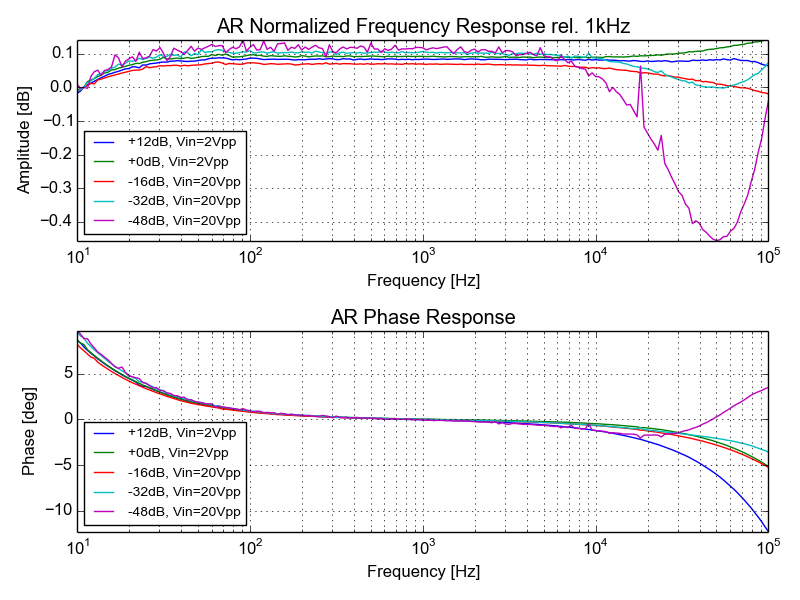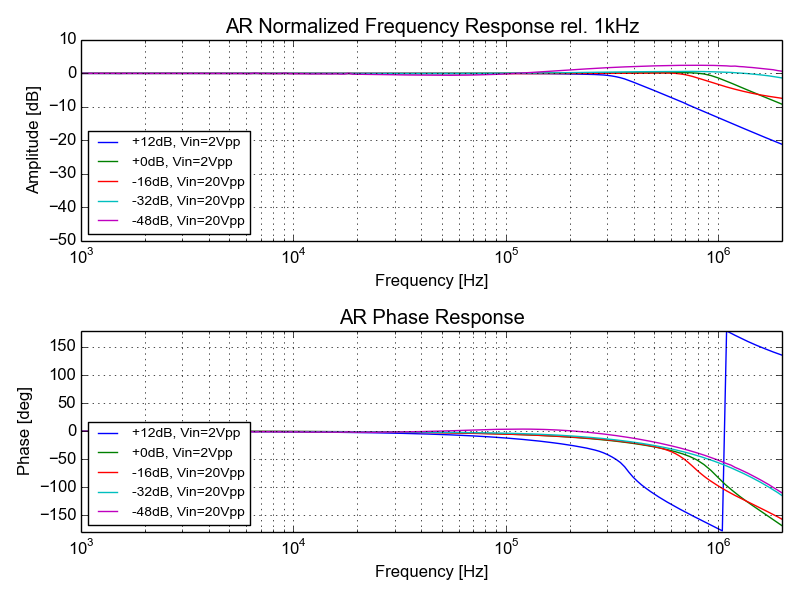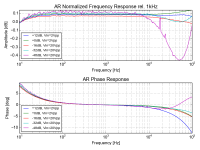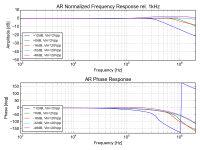Argh, it seems that the Spartan reed relay are out of stock now at Mouser !
Jean-Claude, Digikey has them in stock.
But the specific relay is not critical. As long as it is a small-signal type, same footprint, 5V coil, it will be fine. If you find one, let me know and I can check and put it in the FAQ. I also have a prototype unit with Pickering series 106 type 1F-A which I had, 20 years old -works fine. Omron should also have suitable ones.
Littlefuse has the HE36xx series which is actually from Hamlin before Littlefuse gobbled them up ;-)
No snubber diode required across the coil, but if there is one, that's fine too.
Jan
Last edited:
Hi Jan,
Thanks for the fast answer, they have the same one I guess with the the snubber diode (816-9007-05-01) in stock So I will order them
JC
Thanks for the fast answer, they have the same one I guess with the the snubber diode (816-9007-05-01) in stock So I will order them
JC
Yes those are fine. But be sure to observe corrrect orientation, without the diode they can be both ways, with the diode pin 1 should be at the white square on the PCB.
Jan
Jan
+16dB
Hello Jan,
There was a +16dB output level. Did +16dB go away with the addition the -48dB step?
Thanks DT
...snip...
Physically it will look as shown in the Youtube video. There are some additional functions not mentioned in the video. There are now two front-panel selectable nominal output levels (1V and 0.4V). The attenuation range is increased to -48dB max. to allow max 100VRMS input from your power amp with the lowest nominal (0.4V) output level.
Also, in manual operation you can select 0dB, -16dB, -32dB and -48dB attenuation from the front panel, in addition to the HOLD button freezing the attenuation at the present setting for amplitude sweeping.
...snip...
Jan
Hello Jan,
There was a +16dB output level. Did +16dB go away with the addition the -48dB step?
Thanks DT
I see that the manual "Hold" button will fix the attinuation at 0dB, -16dB, -32dB or -48dB.
Will the hold button lock in the +12dB gain?
DT
Will the hold button lock in the +12dB gain?
DT
The Hold button will lock in, initially, whatever is the current attenuation or gain is. This could be +12dB.
In that situation, the BAL button will switch between 0dB and that locked in setting.
The SE button will cycle between -16dB, -32dB and -48dB.
So your manual settings available are 0, -16, -32, -48 or whatever you had when you pressed HOLD.
But the main use of the unit is of course on auto setting.
Jan
In that situation, the BAL button will switch between 0dB and that locked in setting.
The SE button will cycle between -16dB, -32dB and -48dB.
So your manual settings available are 0, -16, -32, -48 or whatever you had when you pressed HOLD.
But the main use of the unit is of course on auto setting.
Jan
Update:
All ordered and paid for units are send out, either directly to you or to Pilgham for assembly.
Ward is making good progress, and I will coordinate with him on the calibration. I did build up two units on the new boards from the manufacturer and it seems that some of the cap values for calibration need to be adjusted; my hunch is that the PCB material (and maybe the parts) from this new source is slightly different in parasitics. Note that this does only affect the adjustment range to get the calibration correct.
Capacitors C5 and C17 on the atten board (22pF) can be shorted or correct calibration (-48dB) but we are looking in recommending a new value that makes the adjustment a bit less sensitive.
Capacitors C7 and C11 (22pF) on the atten board can be left out.
Capacitors C6 and C10 (510pF) *may* need to be changed in value, will know in a few days.
Again, this is only related to the cal range of the adjustments to null out board and parts parasitics.
Jan
All ordered and paid for units are send out, either directly to you or to Pilgham for assembly.
Ward is making good progress, and I will coordinate with him on the calibration. I did build up two units on the new boards from the manufacturer and it seems that some of the cap values for calibration need to be adjusted; my hunch is that the PCB material (and maybe the parts) from this new source is slightly different in parasitics. Note that this does only affect the adjustment range to get the calibration correct.
Capacitors C5 and C17 on the atten board (22pF) can be shorted or correct calibration (-48dB) but we are looking in recommending a new value that makes the adjustment a bit less sensitive.
Capacitors C7 and C11 (22pF) on the atten board can be left out.
Capacitors C6 and C10 (510pF) *may* need to be changed in value, will know in a few days.
Again, this is only related to the cal range of the adjustments to null out board and parts parasitics.
Jan
Last edited:
Hi Jan,
Just received the autoranger kit! Looks really professional and even better in reality than on the photos! Kudos for such a great tool!
Regards,
Oleg
Just received the autoranger kit! Looks really professional and even better in reality than on the photos! Kudos for such a great tool!
Regards,
Oleg
Hi Jan,
Can you let us know what carrier you used for shipping, and/or send tracking info? That'll help me keep an eye out for it.
BK
Can you let us know what carrier you used for shipping, and/or send tracking info? That'll help me keep an eye out for it.
BK
Package arrived in good nick, I am ordering this SWM6-5-EH-I38 (medical) plug pak (from DigiKey).
Package arrived in good nick, I am ordering this SWM6-5-EH-I38 (medical) plug pak (from DigiKey).
That's seems a good option, but I wonder what the significance is of the '0.1mA leakage current' is. Is that between mains input and output?
Coincidentally, last week I was visiting SY and we did some autoranger measurements with his APx515 and the very lowest noise/distortion was with a powerbank, with a USB charger almost as good.
When supplying the AR from a USB port on the PC running the AP, we saw very low level 1kHz in the spectrum, presumably the USB frame rate. But I am talking sub -130dB here, and we didn't investigate whether it came from the AR or the AP.
With a powerbank the distortion spectrum was essentially the same as the AP loopback.
Jan
...but I wonder what the significance is of the '0.1mA leakage current' is. Is that between mains input and output?...
Me to 🙂 I just went by 'medical' and price (not the cheapest) lets see what happens, I will report back when activated (but this will take a while).
Over the course of people building autorangers, parts values can be refined, as follows:
1. The attenuator board layout shows an SMD 'C13' at the middle front. This capacitor is not fitted at the board and does not need to be fitted.
2. In some cases, the calibration range of the capacitor trimmers is not large enough. For the -48dB calibration, it is recommended to replace capacitors C5 and C17 (22pF) with a 47pF value if available, or just short them. With the -16dB calibration, C7 and C11 (22pF) can simply be left out.
I set up a FAQ at the website where I will try to collect everything that comes out people's experiences with this unit.
Jan
1. The attenuator board layout shows an SMD 'C13' at the middle front. This capacitor is not fitted at the board and does not need to be fitted.
2. In some cases, the calibration range of the capacitor trimmers is not large enough. For the -48dB calibration, it is recommended to replace capacitors C5 and C17 (22pF) with a 47pF value if available, or just short them. With the -16dB calibration, C7 and C11 (22pF) can simply be left out.
I set up a FAQ at the website where I will try to collect everything that comes out people's experiences with this unit.
Jan
if medical, that leakage is supply to ground
above all else, do not flow current thru the patient. 🙂
Alan
above all else, do not flow current thru the patient. 🙂
Alan
Last edited:
Frequency Response Measurements
Altough participating at the RTX GB, I recieved my Auto Ranger Kit two weeks ago. I intend to use the Auto Ranger as a intermediate solution until I've managed to implement auto-ranging for the RTX (since the API is not available yet, this might take some time).
After finishing the initial calibration this morning, I had a brief look at the frequency response. Please take the -48dB plots "with a grain of salt". My TPA6120A2 is able to deliver max 20Vpp on the input of the Auto Ranger, resulting in 80mVpp on the AR-Output. Of course, things get worse at higher frequencies.
I am prety happy with the results!
#1 10Hz-100kHz for all ranges

#2 1kHz-2Mz for all ranges

@Jan: recalibration needed? Another thing: At some levels (i.e. ~1Vpp, but also some others) the AR is not able to settle on a range, it never stops auto-ranging. Any thoughts on this?
Altough participating at the RTX GB, I recieved my Auto Ranger Kit two weeks ago. I intend to use the Auto Ranger as a intermediate solution until I've managed to implement auto-ranging for the RTX (since the API is not available yet, this might take some time).
After finishing the initial calibration this morning, I had a brief look at the frequency response. Please take the -48dB plots "with a grain of salt". My TPA6120A2 is able to deliver max 20Vpp on the input of the Auto Ranger, resulting in 80mVpp on the AR-Output. Of course, things get worse at higher frequencies.
I am prety happy with the results!
#1 10Hz-100kHz for all ranges
#2 1kHz-2Mz for all ranges
@Jan: recalibration needed? Another thing: At some levels (i.e. ~1Vpp, but also some others) the AR is not able to settle on a range, it never stops auto-ranging. Any thoughts on this?
Attachments
Yes that-48dB gets a bit noisy. I do this with a Krohn-Hite 7600 amplifier which can put out almost 100V rms, but most people will not have something like that available.
Depending on the True-RMS meter you have, that -48dB may not be completely accurate. But maybe you could do the cal. with the instrument you used to make the sweep, and then fiddle the -48dB trimmer to get max. flatness.
But at any rate not too bad.
Jan
BTW There is a typo in the cal procedure for Bal -16dB, the trimmer designation should be VC1 not VC3. I will update the data package. Thank you jcga!
Depending on the True-RMS meter you have, that -48dB may not be completely accurate. But maybe you could do the cal. with the instrument you used to make the sweep, and then fiddle the -48dB trimmer to get max. flatness.
But at any rate not too bad.
Jan
BTW There is a typo in the cal procedure for Bal -16dB, the trimmer designation should be VC1 not VC3. I will update the data package. Thank you jcga!
Last edited:
- Home
- Design & Build
- Equipment & Tools
- Autoranger for soundcards

